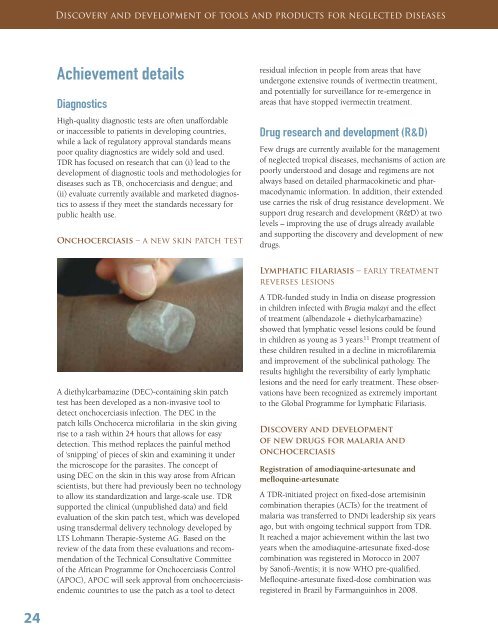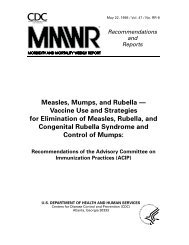documentation - The INCLEN Trust
documentation - The INCLEN Trust
documentation - The INCLEN Trust
- No tags were found...
Create successful ePaper yourself
Turn your PDF publications into a flip-book with our unique Google optimized e-Paper software.
Discovery and development of tools and products for neglected diseasesAchievement detailsDiagnosticsHigh-quality diagnostic tests are often unaffordableor inaccessible to patients in developing countries,while a lack of regulatory approval standards meanspoor quality diagnostics are widely sold and used.TDR has focused on research that can (i) lead to thedevelopment of diagnostic tools and methodologies fordiseases such as TB, onchocerciasis and dengue; and(ii) evaluate currently available and marketed diagnosticsto assess if they meet the standards necessary forpublic health use.Onchocerciasis – a new skin patch testresidual infection in people from areas that haveundergone extensive rounds of ivermectin treatment,and potentially for surveillance for re-emergence inareas that have stopped ivermectin treatment.Drug research and development (R&D)Few drugs are currently available for the managementof neglected tropical diseases, mechanisms of action arepoorly understood and dosage and regimens are notalways based on detailed pharmacokinetic and pharmacodynamicinformation. In addition, their extendeduse carries the risk of drug resistance development. Wesupport drug research and development (R&D) at twolevels – improving the use of drugs already availableand supporting the discovery and development of newdrugs.Lymphatic filariasis – early treatmentreverses lesionsA diethylcarbamazine (DEC)-containing skin patchtest has been developed as a non-invasive tool todetect onchocerciasis infection. <strong>The</strong> DEC in thepatch kills Onchocerca microfilaria in the skin givingrise to a rash within 24 hours that allows for easydetection. This method replaces the painful methodof ‘snipping’ of pieces of skin and examining it underthe microscope for the parasites. <strong>The</strong> concept ofusing DEC on the skin in this way arose from Africanscientists, but there had previously been no technologyto allow its standardization and large-scale use. TDRsupported the clinical (unpublished data) and fieldevaluation of the skin patch test, which was developedusing transdermal delivery technology developed byLTS Lohmann <strong>The</strong>rapie-Systeme AG. Based on thereview of the data from these evaluations and recommendationof the Technical Consultative Committeeof the African Programme for Onchocerciasis Control(APOC), APOC will seek approval from onchocerciasisendemiccountries to use the patch as a tool to detectA TDR-funded study in India on disease progressionin children infected with Brugia malayi and the effectof treatment (albendazole + diethylcarbamazine)showed that lymphatic vessel lesions could be foundin children as young as 3 years. 11 Prompt treatment ofthese children resulted in a decline in microfilaremiaand improvement of the subclinical pathology. <strong>The</strong>results highlight the reversibility of early lymphaticlesions and the need for early treatment. <strong>The</strong>se observationshave been recognized as extremely importantto the Global Programme for Lymphatic Filariasis.Discovery and developmentof new drugs for malaria andonchocerciasisRegistration of amodiaquine-artesunate andmefloquine-artesunateA TDR-initiated project on fixed-dose artemisinincombination therapies (ACTs) for the treatment ofmalaria was transferred to DNDi leadership six yearsago, but with ongoing technical support from TDR.It reached a major achievement within the last twoyears when the amodiaquine-artesunate fixed-dosecombination was registered in Morocco in 2007by Sanofi-Aventis; it is now WHO pre-qualified.Mefloquine-artesunate fixed-dose combination wasregistered in Brazil by Farmanguinhos in 2008.24
















